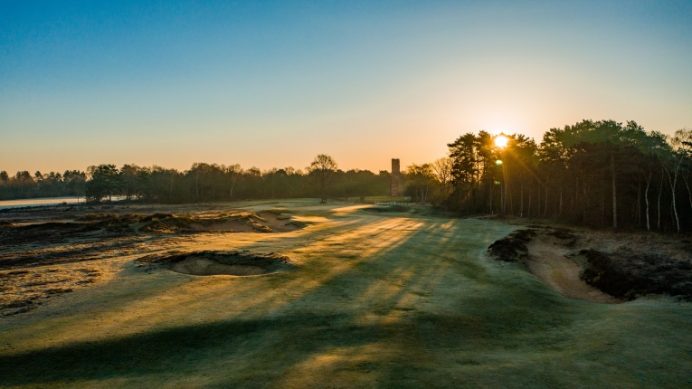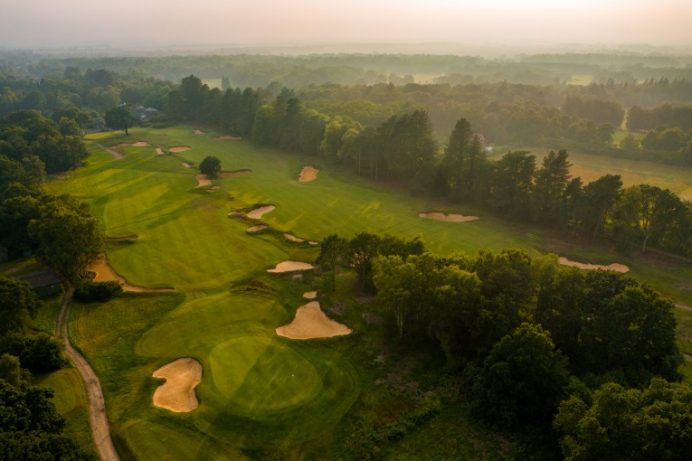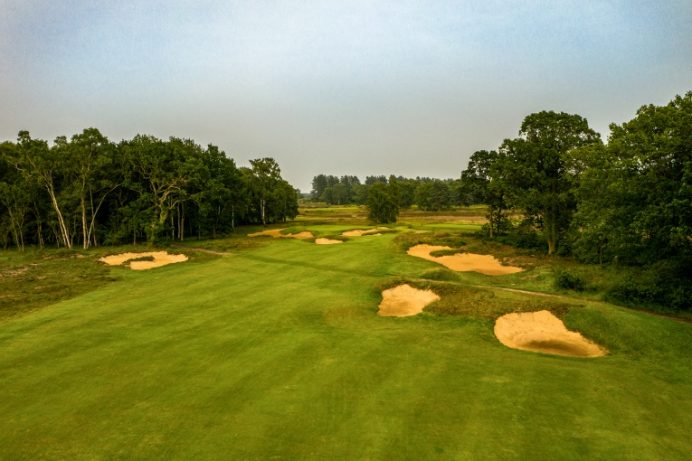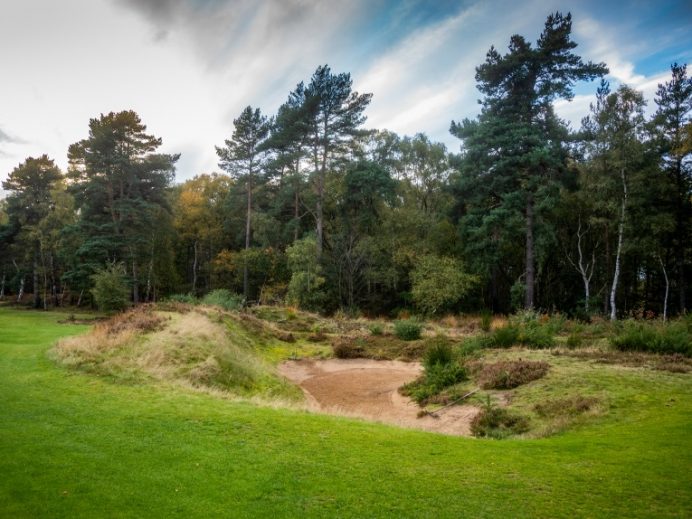Feature Interview with Richard Latham
November, 2021

An iconic photo of Woodhall Spa as the sun peeps over the 3rd green.
Please note: all photos and captions are provided by Clyde Johnson, who worked on the restoration project for Tom Doak.
Richard Latham began playing golf at the age 14 and 4 years later was at scratch. This successful amateur has competed since 1975 , highlighted by an Open appearance in 1985, the Senior Open at Royal Birkdale in 2013, and 3 national senior titles. He was a member of the England Senior team in 2013, 14, 16 and 18 and represented GB&I seniors at the prestigious Concession Cup in Florida in 2014. Mr. Latham graduated with a math degree and originally trained as an aerospace engineer but moved into the golf industry in 1991 by marketing/promoting golf clubs and events. Seven years later he began to run the National Golf Centre and even though he hadn’t intended to stay long, Woodhall Spa became his home and he has devoted his life to making it a truly special place to visit. As its General Manager, he has been involved in all aspects of running the business and overseeing the course including its recent very successful restoration. His interest in golf course architecture started as a hobby of collecting books on the subject but became a passion when he sought to understand why one course was rated higher than another. He began a deep dive on how courses evolved and collated so much detailed information, that publication seemed a natural way to share it. His thoroughly researched books utilize a landscape format that displays great photography and historic maps and his goal is “to produce books in this style for the best courses in the world so that future generations will understand their course’s history before making decisions on future development.” Learn more at www.richardlathamgolfbooks.com.
1. How and when did you become involved in writing books that trace the evolution of golf courses?
My interest in the history of golf course architecture began about 30 years ago when I started to collect books on the subject. I am fascinated by the topography of land forms and how they are used in golf course design. Tracing back the evolution of courses through old photography and then comparing with the modern day layouts became a passion. Figuring out how to display that information for others to enjoy, led to writing books and using graphics to demonstrate the evolution. When I commenced my duties at Woodhall Spa, the history of the Hotchkin Course was not clear and there was little information available. Once I managed to unravel the story, it seemed a logical step to collate the information into a book. I enjoyed the process so much that I started looking at other courses of interest and, in my spare time, have managed to produce other books in the same format.
2. You are a world-class senior player. Does understanding architecture help you compete?
Yes, I believe it does. When you compete, you work out a strategy of how to play a course and, if you understand/respect what the architect was intending, the chances are that you will score better.
3. Your web site, www.richardlathamgolfbooks.com, notes that you have published five books to date, including ones on Muirfield, County Down, Hoylake and Woodhall Spa. How did you source the material for these books? Is there a “next” book?
I worked closely with the clubs involved, who gave me full access to their records. This was the most fascinating and rewarding part as very few clubs have a complete history. I had to look elsewhere for the missing material and when I found it, the story was complete and the clubs were delighted. I built up a network of contacts, which included private individuals with extensive book collections, museum curators, historical aerial photography collections and old newspaper/magazine collections. I’m currently writing a historical golf book at the moment but it is not about golf courses. When that is finished, I will extend the golf course series as there are a few projects currently being discussed.
4. Please give us an overview of the design origins of Woodhall Spa.
The building of the Hotchkin Course began in 1903. It was built on barren heathland where most of the course is on sand. Unusually, it took over two years to build because of the weather conditions and the poor quality of the soil, opening in 1905. The site is relatively flat so designs features were created rather than having the ability to use interesting landforms. Harry Vardon laid out the original course and J H Taylor assisted with bunker positions. The course remained in its original state until 1911 when Harry Colt was invited to review the course. Colt’s legacy is that he introduced a number of new holes and created the routing that we all enjoy today.

Majestic bunker patterns were restored based on historic photographs. Additionally, tree work meant the opening/closing pair of holes as seen above again feels part of the heath.
Between 1926 and 1950, the development of the Hotchkin Course was under the auspices of Colonel Stafford Vere Hotchkin, the owner of the land and the Club. After the First World War, he had developed an interest in golf course architecture and quickly became an authority on the subject. He developed his own course by developing ‘bold’ hazards and lengthened the course by moving tees and greens as equipment evolved. There was little course development over the next 70 years until Tom Doak was approached to review all 18 holes in 2015.
5. Colonel S.V. Hotchkin is an interesting figure in architecture. What have you learned about the man and his design philosophy? How do his other designs compare to Woodhall Spa?
The Colonel was involved in the building of a number of courses and he believed in the following:
- Golf holes are best designed by using natural surroundings and not being made to look artificial.
- If the site allows it, holes should be independent and the golfer should not be distracted by other holes in his vision.
- Avoid blind shots.
- Green entrances should be proportional to the length of shot into the green. The longer the shot, the wider the entrance.
- Make hazards bold – bunkers, in particular.
I have played most of the Hotchkin courses in this country and they all have similarities. In particular, Ashridge and West Sussex are two beautiful courses in wonderful surroundings and have similar features to the Hotchkin Course.
6. Would you categorize Woodhall Spa as part of the penal or strategic school, or both?
I would class the Woodhall Spa course to be both penal and strategic. Penal because so many of the holes require long carries over heather and bunkers – there is no alternative option to those shots. Strategic because of the requirement to place tee shots and second shots into the right position to give you the best chance to score.

The 15th is one of Woodhall Spa’s fine collection of short-fours. Dense birch was removed to the edges to reveal glimpses of a grand avenue of Oak and the bunkering was gloriously restored most notably in the fairway.
7. Colonel Hotchkin’s son, Neil, was involved with the club for quite a while. Tell us about that period of time.
Neil Hotchkin took over the Hotchkin Course in 1953 following the death of his father in that year. Neil looked after the course along similar lines but did not have the architectural knowledge to develop it further. He used Donald Steel as a sounding board for some bunker changes from time to time but did not see the need for a major course overhaul during his time.
There are however two important issues notable from his time in charge:
- Trees were allowed to grow on all parts of the course, which started to change the character of the layout. Neil was happy to allow that to happen and even planted additional species.
- Because the bunkers on the Hotchkin Course are vast, the upkeep is a big commitment. Neil allowed the bunkers to reduce in size and some to grow over. He interpreted his father’s bunker principle of ‘bold’ to mean deep and set about creating smaller but deeper bunkers.
8. How/when did the England Golf Union come to take over the Hotchkin Course?
The English Golf Union (now England Golf) acquired Woodhall Spa in 1995. The EGU at that time was looking for a potential site to build a National Golf Centre and were reviewing various options. Neil Hotchkin had been President of the EGU and was strongly connected with the organisation. He wanted to safeguard the future of the Club and owned enough land around the course to create the facilities the EGU required. Neil’s closet friend was John Flanders who was the Chairman of the EGU and following a discussion on EGU requirements and Neil’s desire for the future of his Club, a mutually agreeable arrangement was reached.
9. What prompted the club to embark on a restoration? How was Tom Doak chosen in 2015? What were the goals?
The restoration of the course was driven by a fall in the world ranking lists and the condition of the bunkers. Because the main feature of the course is the bunkers, their depth and the difficulty of maintaining them was becoming a real issue. It was decided that professional guidance was needed to return the course to its former glory.
The decision to employ an architect was made in 2015 by the Board of the operating company and the process begun to find an appropriate candidate. The selection process involved a number of the leading golf course architects and Tom Doak was chosen because of his personal history and passion for the Hotchkin Course and because it was felt that he offered the most natural solution in renovating a ‘national treasure’.
The goals were to review all 18 holes, re-instate the heathland characteristics and address bunker renovation.

Native growth is punctuated by these natural bunkers.
10. How did the two of you work together?
We worked extremely well together and because it was a collaborative effort between his team shapers and our greenkeeping team, the bond was strong. He appreciated our knowledge of the course evolution and used many of our old photographs as the basis of his restoration plan.
11. What were the most significant changes during the restoration?
The determination of all (the Woodhall Spa team, Tom and Natural England – the site is designated as a Site of Special Scientific Interest (SSSI)) was to return the site to its heathland characteristics by removing trees, scrub and gorse. The bunkers were made to look more natural and more strategic elements have been brought in by subtle changes to green complexes.
12. Did Doak recommend something that surprised you?
The point that surprised us the most was his determination to clear out areas of scrub and gorse on corners of dog-legs, which we thought would make the course easier. We expressed our views at that time and he said ‘trust me – giving a golfer options, creates doubt in their minds’. We followed his advice and then once the season started, we monitored competition results to see what was happening – of course, he was right and even though these holes look less daunting, the results show that they play harder!
13. What are three favourite holes and what makes them so?
The general consensus of opinion is that the 3rd, 11th and 12th are favourite holes. They are probably the most photographed and simply quite beautiful golf holes. They represent the best features of the course and those of a classic British heathland course.

Not all bunkers at at Woodhall are huge, 3 tiny pots were restored right of the infamous 12th green. The flanks of the green were mellowed, ever so slightly, to allow hole locations closer to those nasty hazards.
14. What is the best way for a Golden Age course to offset the gains in distance this century?
This is a challenging question because it very much depends on the space available to a particular course. I believe that the length issue is not all down to improvements in equipment – it is very much linked to the work that golfers are able to do in the gym. Strength & conditioning knowledge has developed so much now, a golfer can now develop their strength to allow them to hit the ball much further. In this case, what happens next when a course does not have the ground to lengthen? I believe that making green complexes more challenging (and that could mean just making them smaller) and more penal for errant shots is probably the way to go.
15. As a past English Senior Amateur Champion, how has the work affected how you play the course?
Strangely enough, I do not score as well as I used to, which could be down to age! Even though the course work was completed in 2019, I still stand on some of the holes and have to really concentrate on the line because it is harder to pick out with less trees. Additionally, the perception of the second shots on some holes has changed due to the clearance work behind the greens.
16. What are the qualities that make heathland golf so alluring?
Heathland courses are naturally beautiful but challenging to play. An abundance of heather, which changes colour throughout the year is always pleasing on the eye and with many evergreen trees, these course also look good in winter. If a course is pleasing on the eye, the ‘alluring factor’ has been achieved. There is a premium on hitting the fairway simply because heather is extremely hard to play from. The sandy nature of the soil also provides great playing surfaces which drain quickly (which is also true of links courses).

A side profile of one the infamous bunkers at the 13th. Woodhall Spa must have the best textures of any course in the world!?
17. What is required for heather to flourish? Is there such a thing as too much heather?
Heather can be a fragile plant, as certain conditions can cause great damage to it. With constant battering from golfers, beetle infestations and extreme dry conditions, heather can struggle to survive. It has to be ‘topped’ from time to time and encouraged to grow by keeping people away from it in extreme cases. Stripping areas and allowing it to re- grow is the best way to make it flourish. We don’t think that there is ever too much heather at Woodhall Spa as we often have to encourage it to re-grow in some places and are constantly monitoring it.
18. What are three favourite ‘under the radar’ gems across GB&I?
There are quite a few – but there are some that perhaps do not receive the accolades that they deserve. I personally like Hillside (next to Royal Birkdale), Parkstone in Dorset and Ashridge in Hertfordshire.
19. Competitor, Author, General Manager all accomplished with aplomb – what’s next?
Well – that’s always a tricky question! I look forward to the future more these days and want to continue to learn about golf courses. I absolutely do not see myself as a golf course architect because I’m not qualified but I am interested in the evolution of courses and intend to continue to study. I would like to add to the series of books that I have written and enjoy being able to help golf clubs understand how their courses have evolved.
Thanks again to Clyde Johnson for his photographs and captions.
The End








